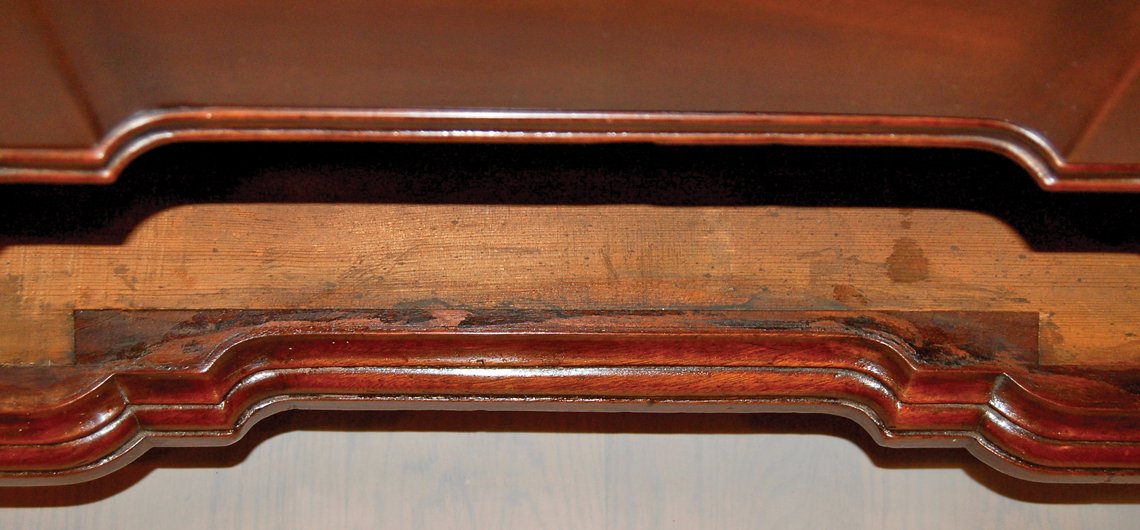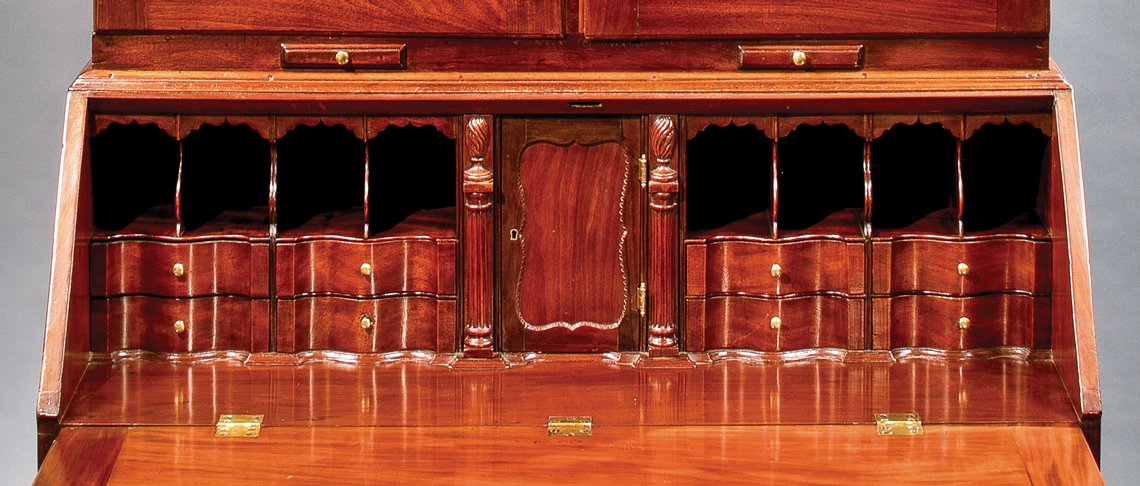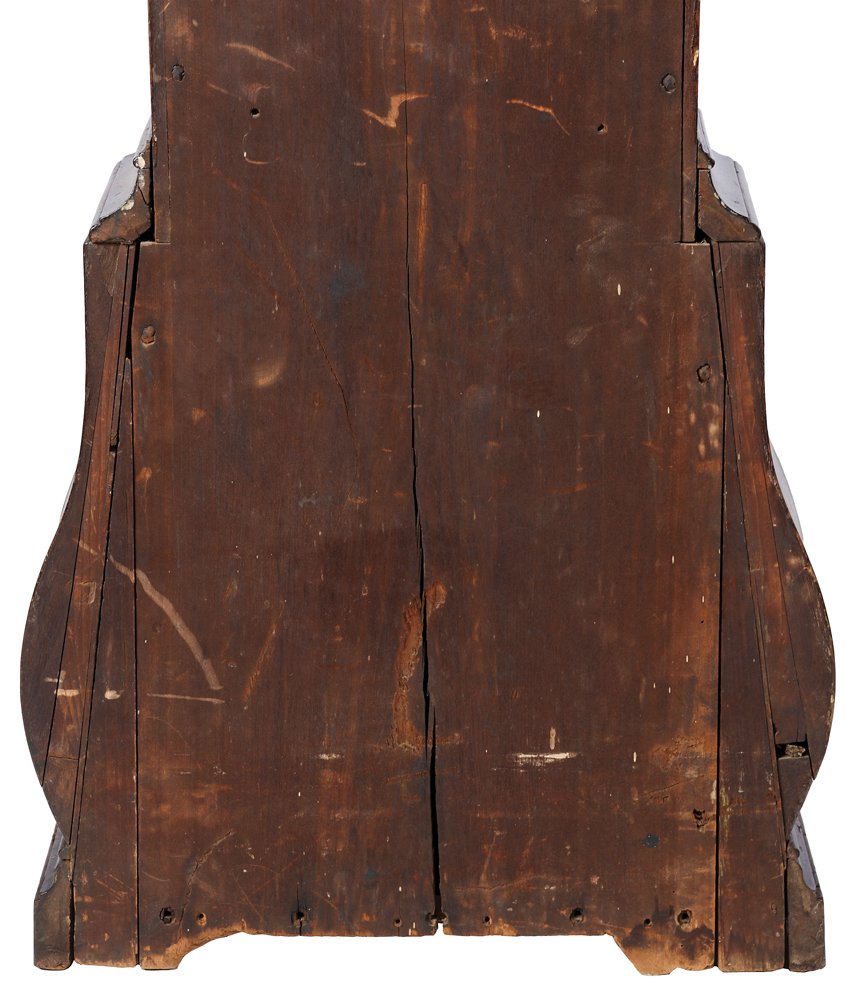Breaking the Rules: Philadelphia Blockfront and Bombé Furniture
 | |
Fig. 1: Blockfront desk and bookcase, Philadelphia, 1760–1785. Mahogany with Atlantic white cedar, hard pine, red or sweet gum. H. 102, W. 42¾, D. 22¾ in. Courtesy, Bernard & S. Dean Levy, Inc. | |
Strong local and regional furniture-making practices — called regionalism — allow early American furniture historians and collectors to identify and better understand the many anonymous examples that have survived generations of use. Regionalism expresses itself in design, materials, and construction. Despite strong and reliable patterns of use and behavior, certain pieces of furniture sometimes challenge well-established regional practices. A blockfront desk and bookcase, a chest of drawers, and a bombé tall clock made in the Philadelphia area bring these conflicts to life.
The grand mahogany desk and bookcase in figure 1 breaks the rules of regionalism. The lower desk section has blockfront drawers, a treatment that occurred in fine furniture made in New England and New York and some isolated communities throughout the South but not Philadelphia.1 Details of this example relate most closely to eastern Massachusetts. The blocked drawer fronts are cut from the solid, rather than laminated as occasionally occurred, and contoured inside. The recessed center of the base molding attaches to the bottom of the case with a giant dovetail, evident in many case pieces made in the Boston area (Fig. 2).2
Design of the pediment, however, is distinctly Philadelphia in use of lobes that project into the round voids flanking the central plinth. These lobes often carried passages of foliate carving applied to the tympanum (or scrollboard). In contrast, New England furniture exhibits round voids without lobes.3 Also, carved “leaf grass” and “egg-and-tongue” moldings decorate the top and bottom of the pediment scrolls and the borders of the door panels. A few case pieces with this particularly ornate treatment were made in Boston and New York, but examples made in Philadelphia more closely represent the rhythms and details of this bookcase section.4
Conflicting regional characteristics led some furniture historians to question the authenticity prior to the deaccessioning of this desk and bookcase. The “curious combination” suggested a marriage, although physical examination yielded no supportive evidence. About 1975, Barry Greenlaw and other examiners noted the same woods in the upper and lower cases as well as the undisturbed fit between them.5 Wood analyses in 1992 confirmed these findings: the top and bottom boards of the bookcase and desk sections have secondary (structural) woods of yellow (or hard) pine; the backboards of each case and the large drawer bottoms are of Atlantic white cedar (with grain running front-to-back); and the small drawer sides in both cases are red or sweet gum. Drawing primarily on the presence of red gum, Greenlaw concluded that the desk and bookcase was made in New York, midway between Philadelphia and Boston.
 |
Fig. 2: Giant dovetail at the bottom of the desk and bookcase in fig. 1. |
 |
Fig. 3: Interior of the desk and bookcase in fig. 1. |
Better information available in the decades since Greenlaw’s study points to a Philadelphia origin. Red gum, for instance, has been identified by microanalysis in some pieces of Philadelphia furniture. Large yellow pine and white cedar boards point to Philadelphia (and south), rather than New York. The absence of white pine leads away from Boston. Aside from wood use, certain features of the desk interior are distinctly Philadelphia. Interiors with pigeonholes over two tiers of drawers with a central prospect door occurred everywhere, but these drawers have serpentine fronts that create a rhythmic façade (Fig. 3).6 Another small, but telling detail is the double-thick vertical pigeonhole dividers that separate the drawers. Although not exclusively used in Philadelphia work, it is far more common there than elsewhere. Design of the scrolled bracket feet, having a notable scroll at the bottom, is not a helpful indicator of origin, since examples are known from different American regions.
Provenance reinforces the physical evidence. In a 1945 auction catalogue, the desk and bookcase was described as from the collection of Miss Elizabeth C. Biddle.7 Born in 1870, she died unmarried in 1947. Her forebears included prominent Biddles and descendants of Bishop William White (1748–1836) and Mayor Michael Keppele (1771–1821), all of Philadelphia.
 |
Fig. 4: Blockfront chest of four drawers, Philadelphia, 1760–1790. Mahogany with Atlantic white cedar, tulip poplar, and white pine. H. 31½, W. 33¾, D. 20⅞ in. Courtesy, Yale University Art Gallery (1930.2149). |
 |
Fig. 5: Blockfront bureau table, Philadelphia, 1760–1790. Mahogany with Atlantic white cedar and tulip poplar. H. 28¾, W. 33¾, D. 21⅝ in. Courtesy, Philip H. Bradley Antiques. |
This object suggests a likely origin for another problematic blockfront chest of drawers long identified as Boston made (Fig. 4). Its uncertain Boston origin stems from secondary wood combinations, namely tulip poplar (Liriodendron tulipifera) drawer sides with white cedar drawer bottoms and backboards, as well as white cedar back and bottom boards of the case. The drawer bottoms run side-to-side, not front-to-back as usual in Philadelphia work, but they have applied running strips with prominent diagonal end-cuts, which are typical. White pine exists only as a few glue blocks. The predominance of tulip poplar and white cedar argues strongly for manufacture in the Philadelphia area. The combination of those woods is not encountered in Boston or New England — where white pine is the secondary wood of choice — nor in New York. A few construction details of this chest, particularly fabrication of the giant dovetail, which is built up by several strips of wood rather than cut from a solid board, differs enough from the desk and bookcase (and from New England prototypes) to suggest another maker, also unknown.
Re-identification of these two blockfront examples paves the way for a third example. A prospect bureau table (popularly called a kneehole desk) recently came to light in the Philadelphia area (Fig. 5).8 It too resembles Boston work but has Philadelphia secondary woods of white cedar and tulip poplar, as well as design and construction details suggestive of Philadelphia such as bracket-foot profiles with deep spurs, a deep overhang of the top in the back, and dovetailed drawers that meet in a miter at the top edges.
As with blockfronts, bombé furniture has long been recognized as premier cabinetry of Boston, Salem, and nearby North Shore communities. This feature, which requires extra wood to fabricate, gives visual weight to the furniture carcass and sympathizes with the naturalism of rococo ornament that accompanies the better examples. The earliest documented example is a Boston desk and bookcase signed by Benjamin Frothingham in 1753.9 Benjamin Frothingham, John Cogswell, and other Boston craftsmen continued to make the form through the end of the century.10
 |  |
Figs. 6, 7: Left: Bombé tall clock, Philadelphia, 1745–1765. Walnut with tulip poplar and hard pine. H. 88, W. 21, D. 11 in. Courtesy, Kelly Kinzle Antiques. Right: Detail of the bombé clock base in fig. 6 showing lamination seams. | |
Furniture historians have described two basic ways of making the bombé form. Thick side boards of the carcass were either cut to shape on the outside only, as on the early Frothingham desk, or the inside was also contoured to the curved shape, as in most other examples. A walnut, Philadelphia-made tall clock case, housing an unsigned eight-day brass movement and dial, employs a third type of construction (Figs. 6 and 7). The bombé form of the base was made by building out each side with pieces of wood to accommodate the curve. The unknown case maker first glued (i.e., laminated) a tapered board made of hard (or “yellow”) pine onto the tulip poplar side of the base section, then laminated another thick board of walnut on top of the pine board. He cut the bombé contour into just this walnut board. This outermost board ends at a seam, visible on the bottom of the curve. Had the maker not added another, short piece of walnut to cover the end of the hard pine, its resinous pine grain would have been distractingly visible immediately above the base moldings. This construction suggests a competent furniture-maker’s effort to fabricate a design that he had seen but had not studied or practiced.11 His inspiration for the bombé shape may have come from imported Dutch or German tall clocks or from printed designs.12
 | |
Fig. 8: Compass-seat side chair, Eastern Pennsylvania, 1750–1775. Walnut. H. 40¼, W. 20½, D. 21 in. Private collection. | |
A Philadelphia origin for the clock acknowledges several observations. Types of secondary woods, notably the tulip poplar backboard and other uses in the case, were popular choices throughout the Philadelphia region as previously noted, as well as elsewhere in the Mid-Atlantic and South. The unusual arched waist door recalls spice boxes and other furniture made in the Philadelphia area.13 Although cataloguing and patterning characteristics of clock dials, engraving, and movements requires further refinement by clock historians, features of the nameless dial (which originally had an arched nameplate below the winding holes) and the clock movement suggest a Philadelphia origin and possible manufacture by Joseph Wills (circa 1700–1759) or Jacob Godschalk (d. 1782).14
Although there is no exact prototype for the patchwork construction of the bombé base of this clock, an eastern Pennsylvania compass-seat side chair exhibits a similar response to the problem of creating a boldly curved shape (Fig. 8). As with the tall clock, this anonymous maker demonstrated accomplished woodworking skills to re-create something he had seen, while showing a lack of familiarity with prevailing construction practices associated with the finished form. The seat rails of Philadelphia compass-seat chairs were typically made with solid pieces of wood that were cut to shape, producing considerable wastage. This maker instead used thinner walnut laminations to fill out each of the side rails at the widest dimension, reminiscent of the clock construction. Faint seams in these curved faces show the separate layers of walnut (Fig. 9). These additional layers extended above the rail to form the rims, which position the slip seat. In urban Philadelphia work, seat rims were either separate pieces of wood glued to the tops of the seat rails, or thicker seat rails were chiseled out to leave integral rims intact.
 |
Fig. 9: Detail of a side rail of the chair in fig. 8 showing lamination seams. Another lamination seam is visible underneath the slip seat on the top of the rail. |
Compass seats were relatively common in urban Philadelphia but not in outlying areas, where this chair was made. Like the clockcase maker, this chair maker transformed a mental image of a compass-seat chair into three dimensions without benefit of direct experience or informed instruction. His effort to overcome inexperience with such chairs is also evident in scored lines along the outside of the seat rims that suggest — but do not mimic — the fuller thumbnail moldings found on many other chairs of this time. Also, the modeling of the knees, which pinch inward at the sides behind the carved shells, shows lack of familiarity with compass seats. This distortion occurred because knee brackets splay wider on a compass-seat chair than on a square-seat chair; experienced chair makers resolved the transition by creating a thicker knee.
These pieces of blockfront and bombé furniture demonstrate the value of weighing all physical evidence when identifying objects. Types of wood, specific construction details, and design nuance all contribute to reliable results. The fact that some objects may lie outside well-established patterns and norms helps test and retest the assumptions of furniture history.
Philip D. Zimmerman is a museum and decorative arts consultant based in Lancaster, Pennsylvania.
This article was originally published in the Summer 2019 issue of Antiques & Fine Art magazine, a fully digitized version of which is available at www.afamag.com. AFA is affiliated with Incollect.com.
1. Blockfront furniture was made in coastal New Hampshire, Massachusetts, Rhode Island, Connecticut, New York, and some isolated communities throughout the South. Lee Ellen Griffith illustrates a Pennsylvania spice box with blocked drawers behind the front door in The Pennsylvania Spice Box: Paneled Doors and Secret Drawers (West Chester, Pa.: Chester County Historical Society, 1986), cat. no. 23. Thanks to Jay Stiefel for this reference.
2. Margaretta Markle Lovell, “Boston Blockfront Furniture,” in Boston Furniture of the Eighteenth Century (Boston, Mass.: Colonial Society of Massachusetts, 1974), 84.
3. See the 1782 John Cogswell chest-on-chest and an unsigned desk and bookcase in Gilbert T. Vincent, “The Bombé Furniture of Boston,” Boston Furniture of the Eighteenth Century (Boston: Colonial Society of Mass., 1974), 179–80, figs. 125–26. Tympanum carving, when it exists on Philadelphia furniture, springs from the void borders rather than from more complex, intertwined compositions across the front.
4. William Macpherson Hornor , Jr., Blue Book, Philadelphia Furniture: William Penn to George Washington (Philadelphia, Pa.: privately printed, 1935), pl. 293; J. Michael Flanigan, American Furniture from the Kaufman Collection Washington, D.C.: National Gallery of Art, 1986), cat. no. 31; Morrison H. Heckscher, American Furniture in The Metropolitan Museum of Art, II, Late Colonial Period: The Queen Anne and Chippendale Styles (New York: Metropolitan Museum of Art/Random House, 1985), cat. no. 166
5. Barry Greenlaw, “Assessing American Furniture: A New Perspective,” Arts in Virginia 16 (1976): 25. Greenlaw reported that the desk and bookcase, owned by the Virginia Museum of Art at the time, had been examined at Winterthur. In the early 1990s, the pediment carving was deemed to be a replacement and was removed.
6. For related interiors, see Hornor, Blue Book, pls. 191–92; Greenlaw, “Assessing American Furniture,” p. 26. Christopher P. Monkhouse and Thomas S. Michie, American Furniture in Pendleton House (Providence, R.I.: Museum of Art, Rhode Island School of Design, 1986), cat. no. 42.
7. Samuel T. Freeman & Co., Rare Early American Furniture, Philadelphia, September 17–20, 1945, lot 263.
8. Thanks to antiques dealer Philip W. Bradley.
9. Clement E. Conger and Alexandra W. Rollins, Treasures of State: Fine and Decorative Arts in the Diplomatic Reception Rooms of the U.S. Department of State (New York: Harry N. Abrams, 1991), cat. no. 13, 94–95.
10. Gilbert T. Vincent, “The Bombé Furniture of Boston,” in Boston Furniture of the Eighteenth Century (Boston: Colonial Society of Mass., 1974), 137–96.
11. A bombé linen press (not examined by the author) has laminated sides to create the bombé shape. It was not identified as Philadelphia, although its carved finial bust was, suggesting reluctance to assign a bombé form to that region. See Sotheby’s, Important Americana: Furniture and Folk Art (New York, January 16-17, 1999, lot 742.
12. Batty Langley, The City and Country Builder’s and Workman’s Treasury of Designs (London 1740), pl. 112; Thomas Chippendale, The Gentleman & Cabinet-Maker’s Director (London 1754), pl. 135.
13. Griffith, Pennsylvania Spice Box, cat. nos. 11, 13, 16, 18–20, 27, 52.
14. Letter to Kelly Kinzle from Edward LaFond dated October 12, 2009, in which clock historian LaFond identifies Wills as the probable maker. The dial bears many similarities to a Godschalk clock in Edwin A. Battison and Patricia E. Kane, The American Clock, 1725-1865: From the Mabel Brady Garvan and Other Collections at Yale University (Greenwich, Conn.: New York Graphic Society, 1973), cat. no. 25.































